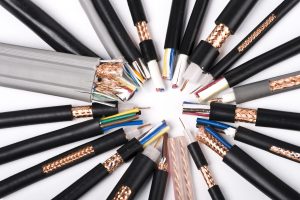 When it comes to designing a cable for a particular application, there are many things to consider – some more obvious than others. Generally customers know the basics like conductor count, AWG size, and shielding, but often times are not as well-versed on the more specific details such as insulation and jacket materials, stranding, etc. Galaxy Wire & Cable is an expert cable solutions provider that will make sure the cable designed is right for the application.
When it comes to designing a cable for a particular application, there are many things to consider – some more obvious than others. Generally customers know the basics like conductor count, AWG size, and shielding, but often times are not as well-versed on the more specific details such as insulation and jacket materials, stranding, etc. Galaxy Wire & Cable is an expert cable solutions provider that will make sure the cable designed is right for the application.
What are the top 5 things to consider when designing a cable?
- Environment
- Overall Size
- Flexibility
- Electrical Requirements
- Standards
1. Environment – Where the Cable is Going to be Used
One of the most important things to consider is the environment in which the cable will be used. Will the cable be exposed to chemicals? Depending on the type of chemical, some cable jackets are superior to others. Perhaps it’s going into a rugged environment, and needs to have good abrasion resistance. Some jackets will fail whereas others will perform just fine. Selecting a cable jacket that takes into account the environmental conditions where it will be used is critical in the performance, and potentially the viability, of the cable itself.
Main Factors to Consider:
- Abrasion resistance
- Chemical exposure
- Suitability
- Resistance
2. Overall Size
The overall size requirements or limitations of the cable are sometimes overlooked. It is important to think about how the cable is going to be terminated. Are pins going to be crimped on the conductors, or will they be soldered? If a backshell is selected already, what are the outside diameter (OD) restrictions? As some components can have long lead times, it’s advised to consider all of these at the time of design.
Main Factors to Consider:
- Conductors
- Fillers
- Diameter
- Crimping pins
- Backshell
- Size of cable fits with usage
3. Flexibility
There are some applications where a cable is installed in a fixed location, and will not move. However, it may be routed in a way that flexibility is important for the installation process. Other cables may be in constant motion with millions of flex cycles. If flexibility is critical, simple things like increased strand count and spiral shields will aid in the performance of the cable. Insulation and jacket materials can have different durometers, and the environment the cable will be exposed to is important to consider as well.
Main Factors to Consider:
- Strain relief
- Bend radius
- Weight
4. Electrical Requirements
Understanding the electrical requirements is critical when it comes to designing a cable. Not only is voltage important to know, but other requirements such as impedance and capacitance need to be evaluated to determine the right type and amount of insulation.
Main Factors to Consider:
- Voltage
- Impedance
- Capacitance
5. Standards Agency Listings
Some customers require their cable to hold an agency listing from organizations like UL (Underwriters Laboratory), CSA (Canadian Standards Association), CE Mark (Certification for European Union), or another accredited firm. This requires careful scrutiny to make sure that a cable designed will be able to hold the required approval. Galaxy can assist in navigating these sometimes confusing standards to make sure the cables have the required listings.
Main Factors to Consider:
- UL certification
- CSA certification
- CE Mark
Contact Galaxy for Custom Cable
Galaxy has vast expertise in assisting OEMs and customers with designing the perfect cable for their application, working collaboratively with customers to develop and manufacture custom cable and wire for many applications. Contact Galaxy today for assistance in producing your custom cable product.
